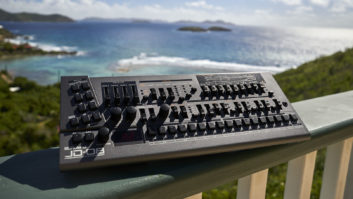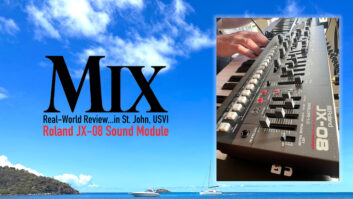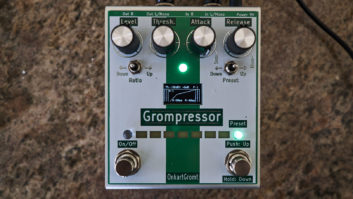
The V-700C controller offers surround, plug-in, screen view, fader and transport control over your DAW.
Roland and Cakewalk have collaborated since the mid-’90s, when Roland became the exclusive distributor of Cakewalk products sold in Japan. Later, in 2003, Roland took on all distribution outside of North America, and by 2008, the company had become the majority shareholder in Cakewalk. This new relationship gave rise to a new brand, Cakewalk by Roland, and its first product: the V-Studio 700 System, which comprises the V-700R rackmount I/O interface, V-700C control surface, SONAR 8 DAW software Rapture virtual instrument and Roland Fantom VS hardware synth. While the controller and I/O interface are optimized for use with SONAR 8, the control surface works with any I/O interface and native DAW, making it a versatile choice for multi-software platform use.
Command and Control
For this test, I interfaced the V-Studio with a machine running a 32-bit Windows Vista Ultimate operating system powered by a 3GHz Intel Core Extreme CPU Q6850 with 4 GB of RAM. Software updates included SONAR 8 to Version 8.3.1, V-Studio 700 software to V. 1.1.1 and a firmware update to V. 1.1. A USB cable connects the V-700R to the computer; a proprietary cable connects the control surface and rack. I used the V-Studio in my home studio and in a commercial studio tracking session. Because I recently reviewed SONAR 8 Producer Edition (see Mix’s April 2009 issue), I will focus on integration between the V-700C, V-700R and SONAR.
The main tactile interface for the system is the V-700C controller. Cakewalk refers to the V-700C as a console, but it’s actually a control surface with the only I/O being a ¼-inch aux input that’s switchable between normal (mic) and hi-Z (instrument) input, and two headphone connections. The rear panel is straightforward with an LCD contrast knob, proprietary socket for connecting to the V-700R, power switch, a USB port and two ¼-inch footswitch connections assignable to a variety of commands. The V-700C is available for purchase separately for use with SONAR 8 Producer and is compatible with other PC-driven DAWs through Mackie Control Universal protocol. (Mac drivers are unavailable.)
Each of the V-700C’s eight channel strips has a blue LCD and comprises a rotary encoder, mute, solo, arm, select, five-segment LED level meter and 100mm motorized fader. A ninth fader is assigned to control the master levels. Banks of eight or single faders can be toggled, and a Flip function allows you to swap the rotary and fader functions. If you select a channel using Shift+Sel, the fader is locked down, which allows access to other fader banks while “freezing” the selected fader on the surface. This was useful for gaining access to group faders, which lets you work with other instruments while maintaining master control. Cakewalk pushes faders to the next level with Channel Branch mode, in which fader 1 controls the volume of the track, while faders 2 through 8 control any assigned sends. The Fader View buttons provide control over other layers, including buses, mains or I/O Control (the V-700R’s mic preamp gain). Currently selected faders can access the Channel Strip Control, which comprises 12 rotary encoders and four buttons that are switchable for EQ, send and ACT (SONAR’s Active Controller Technology) control.
The Access Panel, which has 16 assignable buttons that are configurable for different functions within SONAR, is another great feature. The View buttons — a quick way of switching through all of SONAR’s windows — include computer modifiers and have assignable utility buttons for editing features like cut, copy, paste, etc.
Another standout feature is the T-bar controller, which is assignable to the front/rear balance in surround, any ACT parameter or X-Ray transparency — a SONAR feature that fades out a plug-in, providing access to controls that are below the plug-in window. A Surround section includes a panner joystick, LFE send and a View button that brings up SONAR’s Surround Panner window. Expected controls like transport, monitors and headphone levels are all present. A combo jog/shuttle wheel lets you edit, scroll, zoom or scrub.
Ins and Outs
The V-700R integrates with the V-Studio via USB 2. Also sold separately for I/O expandability, the V-700R houses a Roland Fantom VS hardware synth stocked with more than 1,400 patches and a slot for a Roland ARX sound expansion card (the same one that’s used in the Fantom G keyboard). The Fantom VS works as a VSTi soft synth offering low-latency performance without CPU strain. The rack offers 19 inputs and 24 outputs at 44.1/48 kHz, 15 inputs and 20 outputs at 88.2/96 kHz, and five inputs and 10 outputs at 192 kHz. However, when changing the sample rate, you have to power down, which is a bit time-consuming when changing sessions.
The V-700R’s front panel is sleek, with only a power switch, a rotary sample-rate selector and LED metering for all I/O and sync source. The rear panel is packed with connections ranging from eight balanced/unbalanced inputs on separate XLR and TRS jacks, 10 balanced/unbalanced TRS outputs, XLR stereo main outs and TRS sub outputs. Digital I/O includes Digital 1 (AES/EBU on XLR or S/PDIF), Digital 2 (ADAT optical) and BNC word clock I/O. MIDI I/O, a USB port and a proprietary port for the V-700C complete the rear panel connections.
At Home With the V
I started by patching the V-700R’s main outs into my home studio’s active monitors and created a new 24-bit/88.2kHz session. I inserted SONAR’s Session Drummer 2 over eight tracks, plugged my electric guitar into the V-700C’s aux DI, called up Guitar Rig 3 and dialed in an amp simulation. While balancing my mix, an obtrusive noise came through the monitors whenever I touched any fader and my guitar. I tried different guitars and cables to rule out my equipment but the noise was consistent. A test recording verified that the noise was included in the file; all of the other V-700R inputs were fine. This was also verified by Cakewalk, which reproduced the noise when recording guitar through the DI and an M-Audio ProjectMix I/O.
After spending a couple of hours with the V-700C, I got around the unit and software intuitively. Plug-in manipulation was a breeze with ACT, which brilliantly mapped SONAR’s TL-64 and VC-64 plug-ins to the Channel Strip Control section. I also appreciated how quickly I could access all of the different SONAR views from the Access Panel, while the T-Bar combined with SONAR’s X-Ray kept my plug-ins from cluttering up my screen’s real estate. I could engage mic controls on the V-700C or SONAR’s V-Studio 700 Property applet, with the expected 48-volt, pad, polarity and highpass filter.
In the Studio
For the studio session, I used 23 pre-recorded 24-bit/96kHz tracks with the intention of overdubbing live drums using all eight of the V-700R’s mic preamps. The V-700C doesn’t have a talkback mic, so I used the talkback on the studio’s SSL console. This system is targeted to the home studio user, yet it would benefit greatly from a simple talkback mic, button and output.
Setting mic pre levels with the faders in I/O Control (mic pre) mode was a breeze, but latency reared its ugly head. According to SONAR’s Audio Options, the minimum buffer setting resulted in a total round-trip latency of 8.8 ms, which is intolerable for recording live instruments. The remedy was to feed the cues via direct hardware monitoring on the V-Studio’s Property page (Direct Mix tab). The downside is that Direct Mix can feed only the main, sub or digital outs. The mains were feeding the control room monitors, leaving only the sub outputs available, which receive their level control from the same potentiometer that controls the speakers. The bottom line: There’s no way to control monitor and cue volume separately. I had to feed the cues to the sub outs and was careful not to make any adjustments to the “Monitor” knob while tracking. The ability to send the direct mix out of other outputs would be a simple software routing feature I’d like to see in future releases.
The preamps were clean and detailed, offering plenty of gain and pads for accommodating the hottest signals. My spaced pair of stereo overheads for the drums (Neumann U87 Ai condensers) provided good imaging, sharp snare transient response and smooth high-frequency detail. Mixing the results sounded very good. Another engineer familiar with the pre-recorded tracks commented that this was the best they had ever sounded to him. After the initial recording, I decided to test the V-700R’s digital connectivity with a MOTU 8Pre by feeding the optical inputs. At 48 kHz, this successfully expanded my mic input count to 16 without any problems.
All You Ever Need?
While there are some downsides in the fader/DI noise, lack of talkback or cue system and the need to reboot for sample-rate changes, you can work around these issues fairly easily. The V-700C is a full-blooded control surface that’s tightly integrated with SONAR. Top features include EQ and plug-in manipulation with the Channel Strip Control and the Access Panel’s quick View changes. The V-700C’s faders are a step above the rest with unique features such as Channel Branch mode and locking faders.
The V-700R is a solid 24-bit/192kHz USB interface with a plethora of inputs and outputs that sound clean, detailed and unbiased. The expandable Roland Fantom VS Synth is attractive to keyboardists and also saves CPU load, although it would make more sense for the synth to be a priced option or allow other SONAR synths to take advantage of the Fantom’s processing power. As for SONAR 8, it’s a tried-and-true DAW capable of anything you throw at it, and with its 64-bit processing engine it sounds exceptional.
The bottom line is that the V-Studio 700 is a well-bundled system bringing versatile, pro-level DAW control to the musician.
Tony Nunes is a consultant and engineer, and builds a lot of his own gear.








